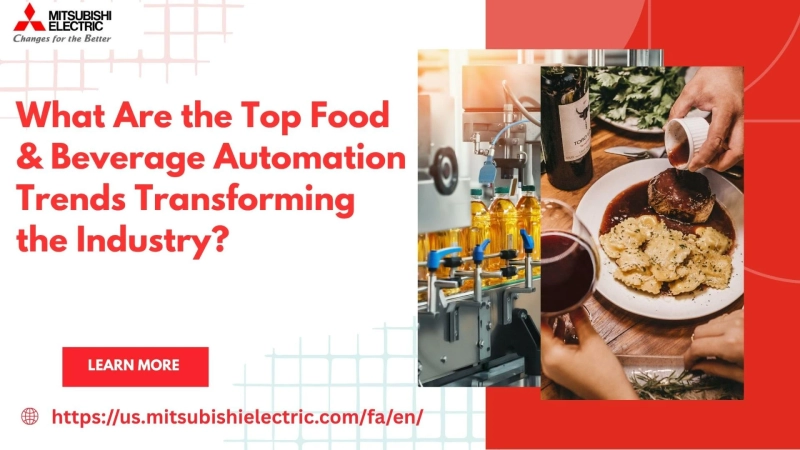The food and beverage sector is well accustomed to change. But the speed and character of its transformation today herald something profound industrial renaissance driven by automation. It started with conveyor belts and basic packaging machines, but now has turned into an intelligent robotics ecosystem, machine learning, and precision automation. These technologies do not only fill in the gaps; rather, they are transforming the entire manufacturing floor altogether
Now, let's see how food & beverage automation is setting some new standards and making work so much easier, especially with the help of automated line robots and end-of-line robotics.
Why Automation Became Necessary
New consumer trends require quicker delivery, wider variety, and fresher choices, all at a reduced price. Conventional production lines cannot meet this formula. That is where automation comes in.
In most food processing facilities, the need to be hygienic, precise, and throughput-intensive at the same time tends to create bottlenecks in operations. Labor, as much as it is valuable, is limited by consistency, downtime, and safety issues. Automation takes away many of these inefficiencies.
But this change isn't merely about velocity. It's about smart manufacturing, decision-making in real time, and quickly adapting without overhauling an entire factory.
Major Trends in Food & Beverage Automation
Let us go through the key trends driving the food and beverage automation of the future.
1. Smart Packaging with End-of-Line Robots
Packaging has become a strategic differentiator from a post-production requirement. End of line robots currently execute high-speed palletizing, case packing, and labeling with precision that's off the charts.
These robots minimize human mistakes and also conserve floor space, enhance worker safety, and lower energy costs. Vision-guided systems and flexible grippers simplify the handling of non-repeating shapes and materials ideal for promotional or seasonal product packaging.
2. Emergence of Automated Line Robots in Continuous Manufacturing
Production lines today work more like living things than strict systems. Automated line robots take care of everything from ingredient sorting to portioning and loading, adjusting with changing production volumes without stopping.
These robots no longer have repetitive tasks as their sole purpose. With embedded AI, they can check food quality, sort according to color or size, and even identify anomalies. This translates to fewer recalls and waste.
3. Integration with Smart Sensors and IoT
Automation based on sensors enables machines to make minute adjustments in real-time. Sensors also ensure that all products are of quality in heating, mixing a vat, altering the state of torque of a packaging unit, and many more.
Used together with IoT networks, such sensors can provide you with a real-time display on the current handle on such measures as machine working levels or predictive failures. Such a degree of transparency translates to smarter choices and a more efficient service.
4. Robotic Sanitation Systems
Sanitizing in food and beverage production is not just hygiene; it's regulation. Robotic sanitation devices are engineered to perform high-pressure washing and disinfecting without interrupting production schedules.
With automation, cleaning is more efficient and consistent. Water use declines. Downtime diminishes. And audit compliance is simpler to document.
5. Modularity and Scalability
The other main benefit of automation systems in the present day is the fact that they are modular. Companies can start small, perhaps by automating the packaging process or sorting, and then build on them without necessarily tearing down existing arrangements.
The strategy allowed for automation even in the facilities of the middle scale and has proven the myth that only global giants can afford robotic systems.
Extravagant Goodnesses Going Beyond Productivity
Speed and accuracy are only a couple of the many advantages of food and beverage automation. This is the reason it is a good investment:
- Better Consistency of Product: With the use of automated systems, products undergo the same accurate specifications in each cycle, thereby reducing variation and producing utmost satisfaction to the customer.
- Less Waste: Automation helps in reducing the loss of raw materials through spillage, overfill, and spoilage, as well as in the realization of sustainability improvement.
- Worker/Employee Empowerment: Automation doesn't dismiss workers; it transfers their roles. The shift is out of repetitive movements into monitoring, analysis, and top-level supervision.
- Better Safety Practices: This will reduce high-risk workers handling a given activity, thus causing a drastic reduction in the chances of getting work injuries and contamination.
- Real-Time Data Access: This can be achieved under an integrated system, as instant feedback is given on production status, quality control, and even the health of operations.
Overcoming Integration Challenges
- Embracing automation is not always straightforward. Legacy systems tend to pose resistance. Still, contemporary control architectures are designed to connect with installed infrastructure via standard protocols.
- Training is another obstacle. There needs to be a new generation of automation-compliant technicians to operate and maintain these systems. Helpfully, most manufacturers provide training modules, remote assistance, and intuitive interfaces that fill the knowledge gap.
- Security is also critical. As systems communicate via networks, safeguarding plant data from cyber attacks is a no-brainer. Spending on secure gateways and firewalls should be a top priority.
What's in Store for Food & Beverage Automation?
The future indicates increasingly deeper convergence between robotics, AI, and cloud computing. Predictive maintenance will become a self-healing system. Robots will work together across production areas. And cloud analytics will inform decisions not only in the plant but throughout the supply chain.
Consumers will lead this change indirectly. Their call for transparency, traceability, and personalization is compelling brands to be more responsive. Agility is what automation brings.
Final Thought: It's Time to Think Differently
Food and beverage automation is not an extravagance or a buzzword within the industry. It's a building block for operations ready for the future. Technologies such as end of line robots and automated line systems aren't just shaving time off the process; they're generating value company-wide.
If your plant hasn't yet considered intelligent automation, now is the time to set aside the manual and gaze toward the modular. The jump might feel formidable, but the ROI speaks volumes.
Start rethinking how your processes flow, and you’ll soon discover how food & beverage automation can turn complexity into clarity.



